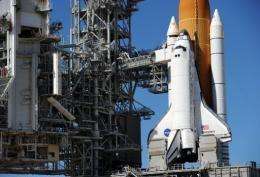NASA picks Thursday for Discovery's final launch

NASA will try next week to launch space shuttle Discovery on its final voyage following a four-month delay for fuel tank repairs.
Liftoff is set for late Thursday afternoon. Senior managers voted unanimously Friday on the new launch date after discussing the fixes made since the shuttle's grounding in early November.
Cracks in the external fuel tank were discovered after a launch attempt was foiled by leaking hydrogen gas. It's taken this long to understand and repair the cracking, which could have harmed the shuttle during liftoff.
The shuttle will carry six astronauts and a humanoid robot, along with a full load of supplies, to the International Space Station. One of the human crew is a substitute, replacing an astronaut who was injured last month in a bicycle crash.
Astronaut Timothy Kopra helped train his fill-in after he stepped down and was instrumental in keeping the flight on track, officials said. He was supposed to be the lead spacewalker.
NASA opted for a Thursday liftoff at 4:50 p.m., even though a European cargo vessel will be docking at the space station that morning. Officials normally prefer more time between arriving spacecraft, but they want to get Discovery flying as soon as possible given its lengthy delay.
The shuttle launch may be put off if something goes wrong with the docking of the European freighter.
As for the cracks in Discovery's external fuel tank, engineers traced the problem to overly brittle material combined with assembly issues. The cracking was confined to some of the aluminum alloy struts in the center of the tank, which holds instruments but no fuel. The damaged struts were patched, and the others reinforced as a precaution.
Mike Moses, a launch manager, described the thin 6-inch patches as metal Band-Aids. Engineers made certain, through testing, that the repairs would not make things worse and introduce even more risk. The overriding objective was "do no harm," he noted.
If any cracking is detected once the tank is filled, the launch will be called off, Moses said.
NASA worried that the underlying cracks could have caused foam insulation to break off the tank and slam into Discovery, as it did during Columbia's doomed mission in 2003.
Another problem cropped up last week: A measuring gauge broke at the launch pad, and one of the falling pieces gouged a tiny slit in the fuel tank foam. No repairs were necessary because of the location on the bottom back side of the tank.
Launch director Mike Leinbach said he was proud of the way the shuttle team paid attention to "not just the 800-pound gorilla" - the fuel tank cracking - but all the other work to ready the shuttle.
Distractions stemming from layoffs and the end of the shuttle program, as well as NASA's uncertain future, have not affected on-the-job performance, Leinbach said. In fact, some laid-off technicians were called back temporarily to help with the fuel tank repairs.
This will represent the end of Discovery's flying career. NASA is retiring the three remaining shuttles this year, leaving orbital trips to private companies so it can focus on interplanetary travel. Until the private sector can take over crew hauls, NASA will have to pay millions of dollars to Russia for astronaut trips to and from the space station.
Getting Discovery off on its final journey - so late - will be like opening Christmas presents the week after, Leinbach said.
"Reprieve, I don't know if that's the right word for it," he told reporters. "People like to see it launch, the fruits of their labor, and that's what we'll get next Thursday."
If all goes well during the shuttle mission, NASA may order up a once-in-a-lifetime photo opportunity before Discovery leaves the space station. One of the Russian capsules briefly would undock for a so-called flyaround, allowing its three-man crew to take pictures of the space station and attached shuttle, as well as cargo ships sent by the Russian, Japanese and European space agencies.
It will be the first time so many spacecraft, representing so many space station partners, are parked at the orbiting lab at the same time.
More information: http://www.nasa.gov/mission-pages/shuttle/main/index.html
©2010 The Associated Press. All rights reserved. This material may not be published, broadcast, rewritten or redistributed.



















